Easter is a time for celebration, family gatherings, and delicious treats. One standout dessert that brings joy to any table is the Easter Cookie Cake.
This treat combines the flavors of classic cookies with the fun shape of a cake, making it perfect for sharing during the holiday.

Creating an Easter Cookie Cake is simple and rewarding. I enjoy using vibrant sprinkles and seasonal candies to make it visually appealing for the occasion.
Whether I’m baking for family or friends, this cake never fails to impress.
Anyone can whip up this delightful dessert with just a few easy steps. If you’re looking to try something new this Easter or just want a fun baking project, the Easter Cookie Cake is a great choice.
Easter Cookie Cake Origins
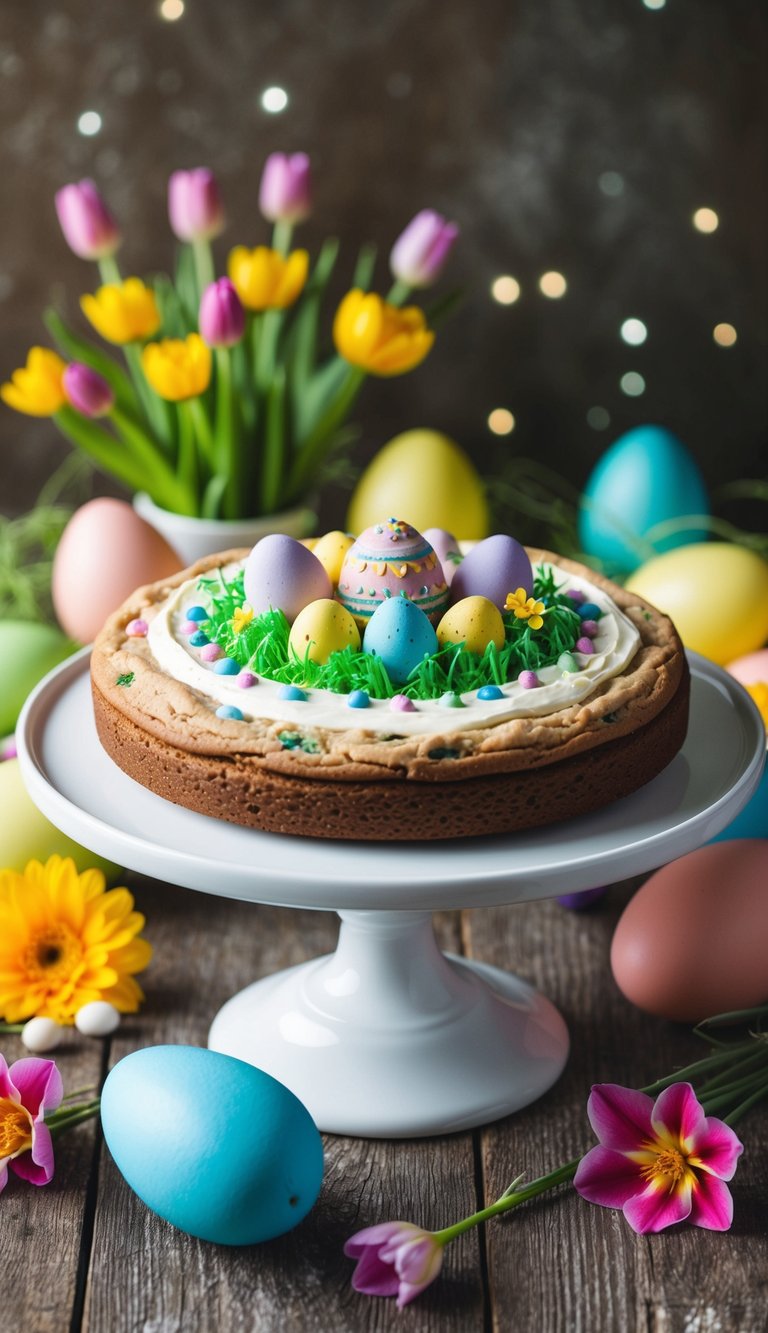
The Easter Cookie Cake has gained popularity in recent years as a festive dessert. Its roots can be traced back to traditional cookie recipes that families have enjoyed during the Easter holiday.
I noticed that many of these cakes incorporate seasonal flavors and colors. Common ingredients often include:
- Butter
- Sugar
- Flour
- Easter-themed candies like chocolate eggs and pastel M&Ms
Baking themes for Easter often focus on sharing and togetherness. The cookie cake is easy to make and serves as a fun centerpiece for family gatherings.
Historical recipes used simpler ingredients, reflecting everyday pantry items. Over time, creativity allowed home bakers to experiment with fillings and toppings.
In some regions, cookie cakes are layered and decorated to resemble traditional Easter symbols, like eggs and bunnies. This adds a playful touch that appeals to children and adults alike.
The blend of cookie and cake allows for a chewy texture, making it a unique treat. I appreciate how this dessert unites baking traditions while adapting to modern tastes.
Families enjoy making this dessert together, creating memories and fostering a sense of celebration. My experiences have shown that the Easter Cookie Cake is much more than just a dessert; it symbolizes joy and communal spirit during the holiday season.
Essential Ingredients
The right ingredients are key to achieving the best flavor and texture when making Easter cookie cake. Understanding the role of each component helps me create a delicious dessert that everyone will enjoy.
Flour Basics
Flour is the backbone of any cake. For Easter Cookie Cake, I prefer using all-purpose flour because it provides the right balance of structure and tenderness.
- Protein Content: All-purpose flour has a protein content of about 10-12%. This is enough to give the cake structure without making it tough.
- Sifting: Sifting the flour before measuring ensures accurate amounts and eliminates lumps.
- Substitutions: If I’m looking for a gluten-free option, I can use a gluten-free flour blend. However, I may need to tweak other ingredients to get the right texture.
Choosing the Right Sugar
Sugar not only sweetens the cake but also affects its texture and moisture. For the best results, I typically use a combination of sugars.
- Brown Sugar: This adds moisture and a slight caramel flavor. It also enhances the chewiness, which I find appealing in cookie cakes.
- Granulated Sugar: This contributes to browning and creates a light texture.
- Powdered Sugar: While not always necessary for the cake itself, dusting on top can elevate the presentation.
Types of Fat
Fat plays a vital role in cake-making. It adds richness and helps create a tender crumb.
- Butter: I usually opt for unsalted butter for its flavor. It creates a rich taste and moisture in the cake.
- Shortening: This can be used for a different texture, making the cake softer. However, it lacks the flavor of butter.
- Oils: Vegetable oil can be an option if I want a lighter texture. It makes the cake moist and tender without adding much flavor.
Eggs and Their Role
Eggs are essential for binding ingredients and adding structure. They contribute moisture and richness to the cake.
- Whole Eggs: Using whole eggs provides the best balance. The whites add structure, while the yolks add fat and flavor.
- Temperature: I always use eggs at room temperature. This helps them mix more easily into the batter.
- Egg Yolk vs. Egg White: If I want a richer cake, I can use more egg yolks. For a lighter texture, extra egg whites can be incorporated.
Leavening Agents
Leavening agents are crucial for the rise of the cake. They make it fluffy and light.
- Baking Soda: This is often included when using brown sugar. It’s important for activating other ingredients and adds a slight rise.
- Baking Powder: A combination of baking soda and an acid, this provides a reliable source of leavening. Using both can yield a lighter cake.
- Testing Freshness: I always check my leavening agents before use. Old baking powder or soda can lead to dense cakes.
Flavoring Components
The flavor is what makes each Easter Cookie Cake unique. I like to enhance my cakes with different extracts and spices.
- Vanilla Extract: This is a standard in most cake recipes. It adds a warm, sweet flavor.
- Almond Extract: A little goes a long way. It gives a distinct flavor that pairs well with chocolate or fruit.
- Spices: Cinnamon or nutmeg can be a nice addition. They offer warmth and depth, perfect for spring celebrations.
By paying attention to these essential ingredients, I can create a delightful Easter Cookie Cake that everyone will love.
Tools and Equipment Needed
Specific tools and equipment are essential to creating a delicious Easter cookie cake. These items help make the baking process easier and more efficient. Here are the key tools to have on hand.
Baking Pans
Choosing the right baking pan is crucial for a successful cookie cake. A round 10-inch tart pan or cake pan works well for shaping the cake and ensures even baking. Some options include:
- Non-stick pans: These make it easier to remove the cake without it sticking.
- Foil pans are easy to use if you’re looking for a disposable option. I’ve found them very handy for quick clean-up.
Make sure to grease the pans lightly before pouring in the batter. This will help in removing the cake after baking, giving it a clean edge.
Mixing Bowls
Having a few mixing bowls in different sizes is important for preparing the cookie batter and any frosting. Here’s what I recommend:
- Large mixing bowl: Use this for combining the dry ingredients and wet ingredients without spilling.
- Medium bowls: Great for mixing small batches of frosting or additional ingredients like chocolate chips.
Look for bowls made of durable materials such as glass or stainless steel. These are easy to clean and won’t stain.
Measuring Tools
Accurate measurements can make or break a recipe. I rely on a few key measuring tools:
- Dry measuring cups: Essential for flour and sugar. They should be leveled off for precise measurements.
- Liquid measuring cups: These have a spout, making it easier to pour wet ingredients like milk or oil.
A good set of measuring spoons is also important for smaller quantities. Using these tools ensures I achieve the right balance in the recipe.
Mixers and Spatulas
A reliable mixer can significantly speed up the mixing process. I typically use:
- Stand mixer: This allows for hands-free mixing and is great for thick dough.
- Hand mixer: A more portable option, ideal for smaller tasks.
Spatulas are critical for scraping down the sides of the bowl and ensuring all ingredients mix evenly. I recommend using silicone or rubber spatulas as they are heat-resistant and easy to clean.
Step-by-Step Baking Process
Baking an Easter cookie cake involves several important steps, each contributing to the cake’s final texture and flavor. I will guide you through preparing the dough, shaping the cake, and properly baking it.
Preparing the Dough
To start, I melt the butter in a large, microwave-safe bowl. I must let it cool slightly before adding the eggs.
Then, I whisk together the dry ingredients, which typically include flour, baking soda, and a pinch of salt.
Next, I combine the wet and dry ingredients. It’s important to mix until just combined to avoid a tough texture.
If I want a unique taste, I can add vanilla extract or other flavorings. Finally, folding in chocolate chips or pastel candies gives the dough a festive touch.
Cake Shaping Techniques
Shaping the cookie cake is a crucial step. I often use a round cake pan or a foil pan for easy release.
First, I lined the pan with parchment paper to prevent sticking. Then, I spread the dough evenly in the pan, making sure to smooth the top.
For a personalized look, I can create swirls or patterns in the dough. Another option is to press different candies on top before baking, adding a fun design.
It’s important to leave a little space between the dough and the edge of the pan, as it will expand while baking.
Baking Times and Temperatures
Next, I preheat the oven to 350°F (175°C). This temperature is ideal for ensuring the cake bakes evenly.
I usually bake the cake for about 18-20 minutes, but it’s crucial to keep an eye on it. The edges should turn a light golden brown.
To check for doneness, I insert a toothpick into the center. If it comes out clean or with a few moist crumbs, it’s ready.
If it’s wet, I add a couple more minutes of bake time. Every oven is different, so adjustments may be needed based on how my cake is doing.
Cooling and Handling
Once baked, I remove the cake from the oven and let it cool in the pan for about 10 minutes. This short cooling period allows it to set.
After that, I carefully flip it onto a wire rack to cool completely.
Cooling is essential for easy handling and decorating. If I try to frost it too soon, the icing may melt or slide off.
Once the cake is cool, I can frost it with my favorite buttercream or cream cheese icing and decorate it as desired. This stage is where I can get creative with toppings and colors.
Decoration and Presentation
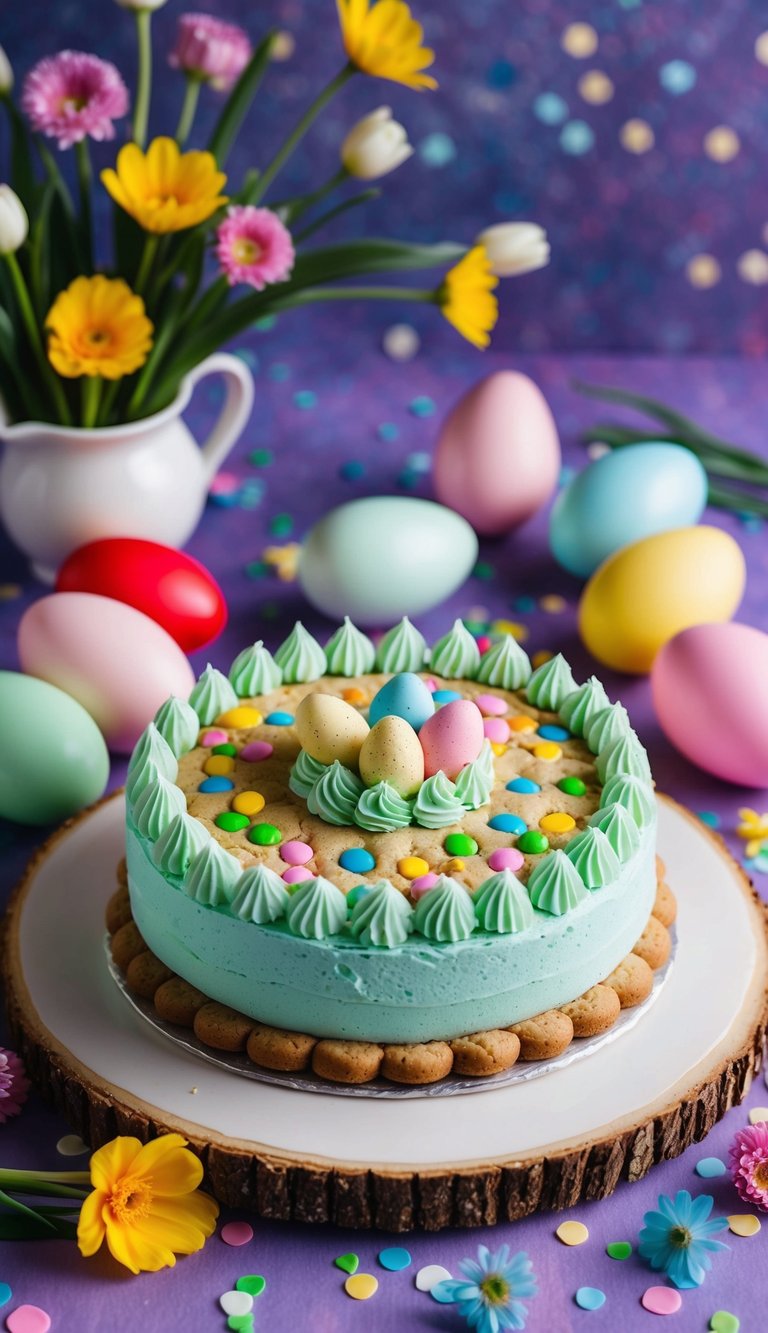
When it comes to decorating and presenting an Easter Cookie Cake, creativity plays a key role. I focus on using vibrant colors and playful designs to enhance the festive appeal. Here are specific ideas for icing, toppings, and thematic presentations.
Icing Varieties
I often choose a variety of icings to create depth and texture. Common choices include:
- Buttercream: Smooth and easy to pipe, perfect for creating borders and decorative flowers.
- Royal Icing: Ideal for more intricate designs as it dries hard, allowing for detailed work.
- Cream Cheese Frosting: A delicious option that pairs well with cookie cakes for a tangy flavor.
To make colored icing, I mix food coloring with a basic icing recipe. This allows the cake to shine with lively pastel shades, fitting the Easter theme.
Decorative Toppings
Adding toppings can transform an ordinary cookie cake into a stunning centerpiece. Here are some of my favorites:
- Easter Candy: Mini chocolate eggs, jellybeans, and peeps add a fun touch.
- Sprinkles: Using pastel sprinkles gives a festive look and a bit of crunch.
- Fruits: Slices of strawberries or blueberries can add freshness.
I like to arrange these toppings in patterns, creating visual interest. Using different shapes makes the cake more inviting.
Thematic Presentation Ideas
Presentation matters just as much as decoration. I consider these ideas to enhance the festive atmosphere:
- Platter Selection: A colorful spring-themed platter can complement the cookie cake.
- Garnishes: Fresh mint leaves or edible flowers around the base can enhance the look.
- Serving Style: Presenting the cake with themed napkins or plates makes serving more festive.
I also suggest creating a small display of related treats to surround the cake. This level of detail really captures the spirit of Easter.
Customization Ideas
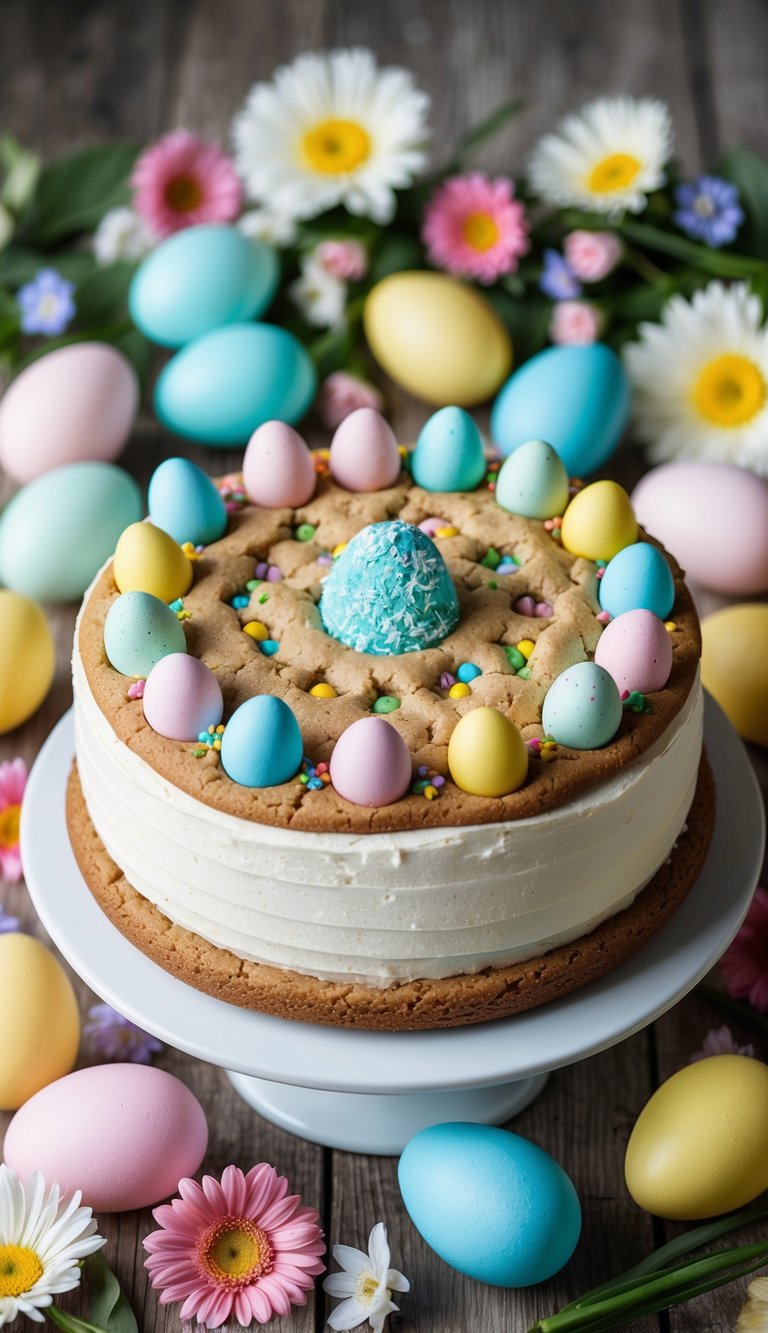
Easter Cookie Cakes offer a fun way to celebrate the season, and customizing them can enhance their appeal. I have some great ideas for flavors, dietary needs, and colorful decorations to make your cake truly unique.
Alternative Flavor Profiles
While traditional chocolate chip or sugar cookie bases are popular, exploring different flavors can elevate your Easter Cookie Cake. Here are some ideas:
- Lemon: A zesty lemon cookie brings a refreshing taste.
- Carrot Cake: Combining spices with grated carrots creates a seasonal favorite.
- Red Velvet: This appealing cake adds a unique twist with its vibrant color and cream cheese frosting.
To enhance the flavor, I like to add extracts, such as almond or vanilla. You can also mix in chocolate chips, nuts, or dried fruits. Experimenting with flavors keeps your dessert exciting and appealing to a wide range of tastes.
Dietary Variations
Making your Easter Cookie Cake inclusive means catering to different dietary needs. Here are some options to consider:
- Gluten-Free: Use gluten-free flour blends to create a delicious cake for those with gluten sensitivities.
- Vegan: Substitute eggs with applesauce or flaxseed, and use plant-based butter for a vegan version.
- Low-Sugar: You can reduce sugar content or swap refined sugar for natural sweeteners like honey or maple syrup.
Ensuring that everyone can enjoy the cake makes the celebration more joyful. Being mindful of these variations allows me to share Easter treats with friends and family without worry.
Adding Colorful Accents
Decoration is key to making an Easter Cookie Cake stand out. Here are some vibrant ideas for accents:
- Frosting: Use bright colors for the frosting. Pastel tones work beautifully for Easter themes.
- Sprinkles: Add colorful sprinkles for a festive touch. I find Easter-themed sprinkles particularly fun.
- Edible Flowers: Consider garnishing with edible flowers for a lovely spring look.
I often use piping techniques to create fun designs on top of the frosting. Getting creative with the decorations can really bring the Easter spirit to life in my cookie cake.
Storage and Freshness
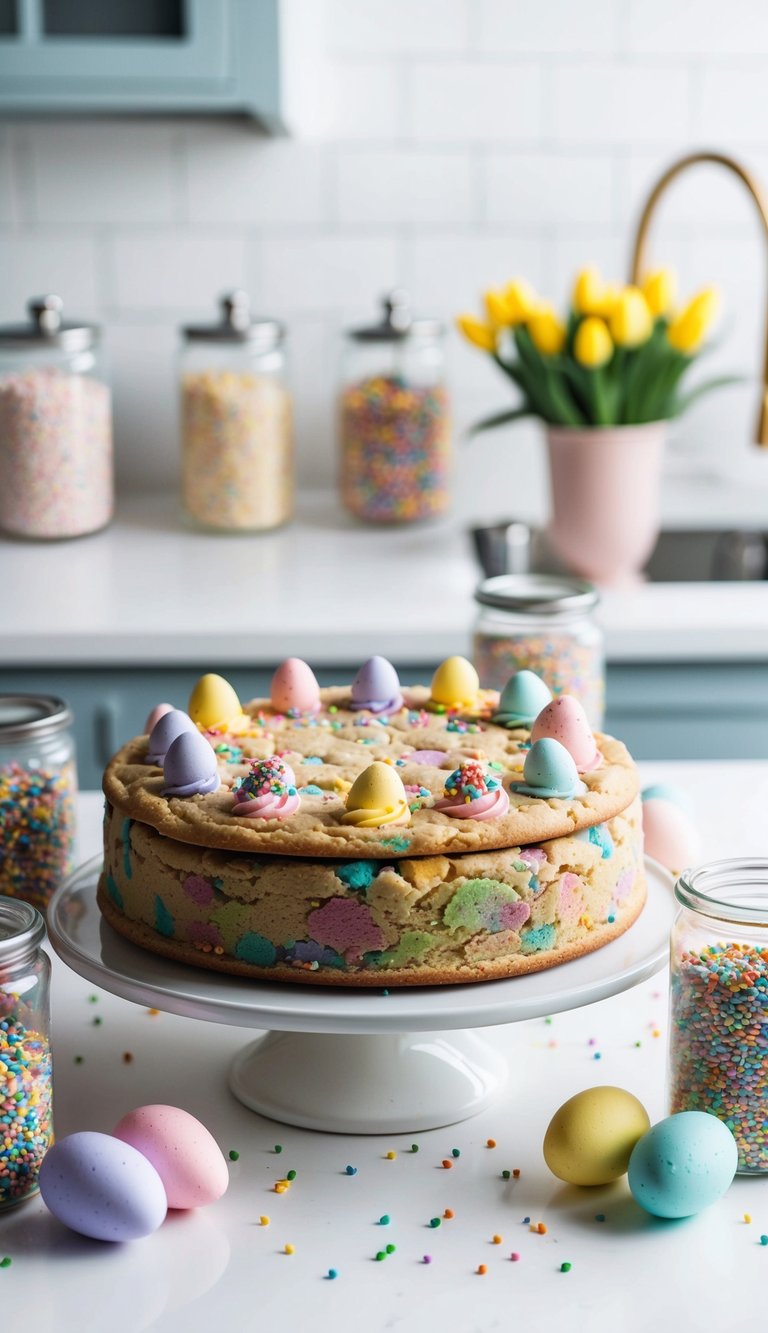
Keeping your Easter Cookie Cake fresh is important for maintaining its delicious taste and texture. Proper storage techniques can extend its shelf life. Here’s how to do it effectively.
Proper Storage Techniques
To store your Easter Cookie Cake properly, wrap it tightly in plastic wrap or aluminum foil. This helps prevent it from drying out.
- Airtight Container: Place the wrapped cake in an airtight container for extra protection.
- Refrigeration: If you plan to keep the cake for a few days, refrigerate it to help maintain its freshness.
- Room Temperature: If covered, the cake can stay at room temperature for short-term storage. Just make sure it’s tightly sealed.
Avoid exposing the cake to air, as this can lead to hardening or going stale.
Shelf Life Considerations
The shelf life of your Easter Cookie Cake depends on how you store it.
- Refrigerated: When stored in the refrigerator, it usually lasts about 3 to 4 days.
- Room Temperature: If kept at room temperature, it can remain fresh for about 2 to 3 days.
- Freezing: If you want to store it longer, consider freezing it. Wrap it well, and it can last up to 3 months in the freezer.
To thaw, leave it in the fridge overnight before serving. This keeps it tasting fresh.
Serving Suggestions
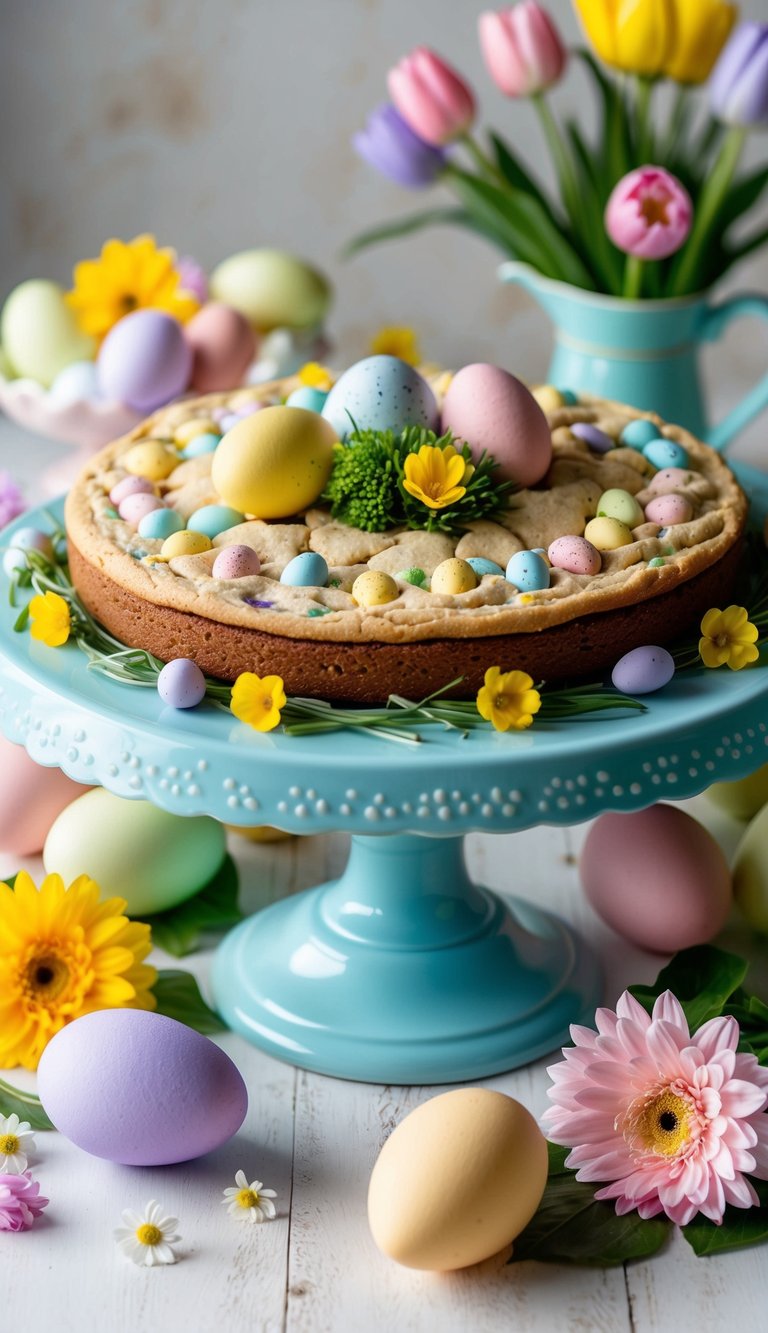
When serving an Easter Cookie Cake, presentation and beverage pairing can enhance the experience. I find that these two elements are key in making the dessert enjoyable for everyone.
Plating Techniques
Plating can transform a simple dessert into a feast for the eyes. Here are some techniques I use:
- Slice Neatly: Use a sharp knife for clean cuts. This ensures each piece looks appealing.
- Wedge Style: Cut the cake into wedges like a pie. This makes it easy for guests to serve themselves.
- Color Contrast: Place the cake on a white plate to highlight its vibrant colors, especially if decorated with frosting and candy.
- Fresh Garnishes: Add fresh fruits or mint leaves on the side for a pop of color and freshness.
These techniques not only enhance visual appeal but also make serving easier.
Pairing with Beverages
Choosing the right beverage can elevate the enjoyment of an Easter Cookie Cake. Here are some options:
- Milk: A classic choice that balances sweetness. Consider both whole and chocolate milk for variety.
- Coffee: The rich flavors of coffee can complement the sweetness of the cake. I recommend serving it hot or iced.
- Tea: Herbal teas pair nicely with the cake without overpowering it. Look for those with hints of fruit or floral notes.
- Sparkling Water: For a refreshing touch, serve the cake alongside sparkling water. This can cleanse the palate.

Ella Foster, co-founder of FoodBears.com, is a skilled writer whose love for cooking fuels her creative work. Her passion for experimenting in the kitchen brings authentic flavor and culinary inspiration to every piece she crafts for the platform.
